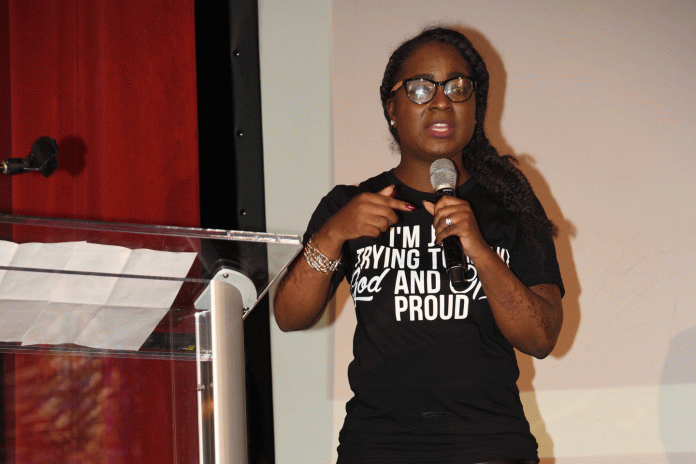“Lupus is not some distant disease,” Gabrielle Davis, founder of Lupus Sistas, tells Black Health Matters just days before the Black Health Matters Summit. In fact, lupus is an urgent matter. “It is rampant in the black community. It is having devastating effects on women, specifically black women.”
It is with this same passion that Davis, a lupus sufferer and advocate, addresses the crowd at Riverside Church in Harlem, New York.
“Nine years ago, my life changed,” she says. “I was young, slim, cute. I was a newlywed. It was my first Valentine’s Day as a married woman.
She goes on to explain how she was having pain that day, but she passed it off as stress. So she booked a massage, which only exacerbated the problem.
“By the time I got off the table, I could barely walk,” she says. “We couldn’t do Valentine’s Day; we had to go to the ER.”
The doctors said Davis’ white blood cell count was out of whack and she was severely dehydrated, but they had no idea what was wrong with the newlywed. Though her primary care physician caught on that Davis was suffering from an autoimmune-related disease, she didn’t see a rheumatologist until three or four months later.
That’s when she learned she had lupus.
Lupus comes in three main forms:
- Systemic lupus erythematosus is the most common form of the disease, and it involves the entire body.
- Cutaneous lupus causes a rash and lesions on the skin.
- Drug-induced lupus, which occurs when a doctor prescribes a medicine that causes lupus symptoms, usually goes away when the medication is stopped.
Davis was diagnosed with SLE. “It was a devastating diagnosis,” she reveals. “And one I didn’t take as seriously as I should.”
She takes prednisone, which has given her a moon face. She also suffers from joint problems, especially if it’s really cold or damp and humid. She jokes about buying stock in Aspercreme. And she has experienced hair loss.
The fatigue that marks the disease has most severely cramped her lifestyle. “It’s the symptom that bothers us the most,” she says. “It stops us dead in our tracks. There were times it was truly a stretch to get up off the couch.”
But perhaps her biggest lupus challenge came about a year after her initial diagnosis. “In 2010, I was diagnosed with kidney disease,” she says. At first she was able to manage the additional health threat, but by 2016, her kidney function had dipped to 4 percent. Her doctors said it was time to think about dialysis.
She wanted to handle the new diagnosis with exercise and diet. “I said, ‘Let me get my green smoothie on,’ but sometimes we have to take the medicine, and my medicine was dialysis,” she says.
Davis pulls up her shirt to reveal her catheter. “I do nine hours of dialysis with my boyfriend, Baxter,” she says jokingly. Then, serious, again, she adds: “This is my lifeline now.”
Davis’ mission isn’t only to share her own story, though her real-world examples of how lupus has affected her are an engaging way to grab an audience’s attention. “I’m just one of many people living with lupus today. I’m able to hold down a full-time job still. Some can’t,” she says.
Her bigger goal is to spread lupus awareness.
And so she shares these facts:
- Nine out of 10 lupus patients are women.
- 40 percent to 50 percent of sufferers will have organ involvement.
- 1.5 million people in the United States are living with this disease. But that’s a conservative estimate, she explains. “Lupus isn’t tracked well and doesn’t appear on your death certificate.”
- Black women are two to three times more likely to be diagnosed than white women; men are diagnosed less often, but they tend to have more severe symptoms.
Celebrities with lupus—Davis cites Toni Braxton, Nick Cannon, Selena Gomez and Lady Gaga—are doing their part, alongside organizations like the Lupus Foundation of America and the Lupus Research Alliance.
But it’s not enough.
“We are the foot soldiers spreading awareness about this disease,” Davis says, “asking for funding and more research.
“The black community has been speaking up more lately. Now it’s time to make a difference in our health. Advocacy starts with health.”
With that in mind, what can you do? Davis offers these tips:
- Educate yourself. Know the symptoms, which include malar rash, raised red patches, photosensitivity, mouth or nose ulcers, arthritis in two or more joints, inflammation, seizures and psychosis, kidney problems and blood disorders.
- Ask for a full blood workup. Your doctor should look for antibodies to double-stranded DNDA and antinuclear antibodies.
- Be a myth buster. “Lupus is not contagious,” Davis says. “And it’s not HIV.”
- Get involved in clinical trials. “I understand America has a past about testing and medication. I know about Tuskegee,” she says, “but we can no longer say we need a cure to a disease and we’re not a part of the research. We to be a part of the trials. Reach out to lupus organizations in your community and ask what you can do. Doing the most you can in your own circle is the most you can do.”
- Be informed. Even if you don’t have the disease, chances are you know someone who does. Learn how to support the people in your life who have lupus.






